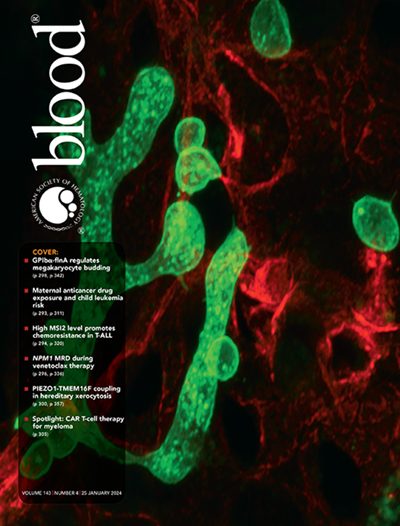Structure and interactions of the proteins from the contact system.
IF 21
1区 医学
Q1 HEMATOLOGY
引用次数: 0
Abstract
The contact system includes factor XII (FXII), factor XI (FXI), prekallikrein (PK) and high-molecular weight kininogen (HK) and has received increased interest as a potential target in immunothrombotic and inflammatory diseases. This system activates two distinct pathways, the intrinsic pathway of coagulation via cleavage of factor IX (FIX) and inflammation via HK cleavage resulting in bradykinin (BK) generation. HK is central to the function of both arms of the system as a substrate for plasma kallikrein (PKa) and critical cofactor which forms interactions with cell receptors and activators. Both FXI and PK circulate in complex with HK and both can be activated by factor XIIa (FXIIa). Reciprocal activation and continuous consumption of PK and FXII is a feature of the contact system. On endothelial cells, PK and FXII become activated but only in the presence of secreted receptor for the globular domain of C1q (gC1qR) and Zn2+ ions. A second mechanism exists on endothelial cells whereby prolylcarboxypeptidase activates the PK-HK complex to generate BK in a FXII independent manner. On platelets, FXI can be cleaved by thrombin, but only in the presence of secreted polyphosphate. This review explores the 3D structure of the contact factors and examines the molecular mechanisms underlying contact activation. We focus on conformational changes that expose cleavage sites and exosites in FXII, PK, and FXI. We also discuss contact factor protein-protein interactions, recognition of polyanions and the role of HK and Zn²⁺ in contact system assembly.接触系统中蛋白质的结构和相互作用。
该接触系统包括因子XII (FXII)、因子XI (FXI)、prekallikrein (PK)和高分子量激肽原(HK),作为免疫血栓形成和炎症性疾病的潜在靶点受到越来越多的关注。该系统激活两种不同的途径,一种是通过切割因子IX (FIX)进行凝血的内在途径,另一种是通过切割导致缓激素(BK)产生的HK引起炎症。作为血浆钾激肽(PKa)的底物和与细胞受体和激活剂形成相互作用的关键辅因子,HK对该系统的两个分支的功能至关重要。FXI和PK与HK复合物循环,均可被XIIa因子(FXIIa)激活。PK和FXII的相互激活和持续消耗是接触系统的一个特征。在内皮细胞上,只有在C1q (gC1qR)和Zn2+离子的球状结构域分泌受体存在时,PK和FXII才会被激活。内皮细胞存在第二种机制,即脯氨酸羧肽酶激活PK-HK复合物,以FXII独立的方式产生BK。在血小板上,FXI可以被凝血酶切割,但只有在分泌的多磷酸盐存在的情况下。本文探讨了接触因子的三维结构,并探讨了接触激活的分子机制。我们重点研究了FXII、PK和FXI中裂解位点和外源位点的构象变化。我们还讨论了接触因子蛋白质-蛋白质相互作用、多阴离子的识别以及HK和Zn 2⁺在接触系统组装中的作用。
本文章由计算机程序翻译,如有差异,请以英文原文为准。
求助全文
约1分钟内获得全文
求助全文
来源期刊

Blood
医学-血液学
CiteScore
23.60
自引率
3.90%
发文量
955
审稿时长
1 months
期刊介绍:
Blood, the official journal of the American Society of Hematology, published online and in print, provides an international forum for the publication of original articles describing basic laboratory, translational, and clinical investigations in hematology. Primary research articles will be published under the following scientific categories: Clinical Trials and Observations; Gene Therapy; Hematopoiesis and Stem Cells; Immunobiology and Immunotherapy scope; Myeloid Neoplasia; Lymphoid Neoplasia; Phagocytes, Granulocytes and Myelopoiesis; Platelets and Thrombopoiesis; Red Cells, Iron and Erythropoiesis; Thrombosis and Hemostasis; Transfusion Medicine; Transplantation; and Vascular Biology. Papers can be listed under more than one category as appropriate.
 求助内容:
求助内容: 应助结果提醒方式:
应助结果提醒方式:


